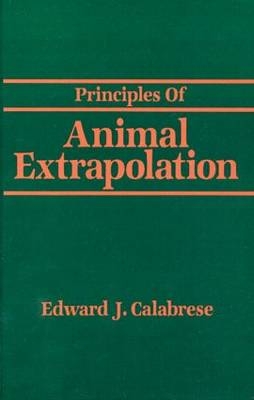
Principles of Animal Extrapolation
Crc Press Inc (Verlag)
978-0-87371-410-5 (ISBN)
- Titel ist leider vergriffen;
keine Neuauflage - Artikel merken
Principles of Animal Extrapolation addresses the conceptual basis for animal extrapolation and provides an abundance of documentation that illustrates how these principles may be applied in the selection of the more appropriate models and in the interpretation of toxicological studies. The book analyzes and documents each specific biological cause of interspecies differences in susceptibility to toxic agents, including differences in absorption, gut flora, tissue distribution, metabolism, mechanisms and efficiencies of repair, and excretion. The problem of the heterogenicity of the human population is addressed through several chapters that assess the availability and prospects of developing predictive animal models for normal humans, as well as selected potential high-risk groups. Other topics presented in this book include the biological basis of regulatory actions involving attempts to extrapolate from exceptionally high exposure levels to realistic values, especially carcinogens; an assessment of genotoxicity tests, their ability to predict carcinogenicity in whole animals, and the manner in which they should be used by regulatory agencies; birth defects; and predicting the risk of human teratogenesis.
Principle of Animal Extrapolation is essential for environmental toxicologists. It also provides valuable information to biomedical scientists (especially those involved in drug development and testing) and regulatory personnel in agencies such as the EPA, the OSHA, the NIOSH, and the FDA.
ANIMAL EXTRAPOLATION: AN INTRODUCTION. Federal Legislation and Predictive Toxicology. The Early Use of Animal Models. How Much Testing Is Needed? Are Perfect Testing Schemes Possible? Inadequacies of Present Predictive Schemes. Animal Rights, Humane Considerations, and Human Needs. Educating the Public: Perception Versus Reality. Regulatory Needs. ABSORPTION: INTERSPECIES DIFFERENCES. The Gastrointestinal Tract. Dermal Absorption. Respiratory Tract Absorption. INTESTINAL MICROFLORA. Introduction. Interspecies Differences. Summary. TISSUE DISTRIBUTION: INTERSPECIES DIFFERENCES. Protein Binding. Biliary Excretion. The Blood-Brain Barrier: The Toxicological Implications of Interspecies Differences in Maturation. Interspecies Differences in the Tissue Distribution of Mercury. COMPARATIVE METABOLISM: THE PRINCIPAL CAUSE OF DIFFERENTIAL SUSCEPTIBILITY TO TOXIC AND CARCINOGENIC AGENTS. General Principles. Organophosphate Insecticides: A Specific Application. Other Examples. A REEVALUATION OF THE RAT AS A LABORATORY ANIMAL. ANIMAL MODELS FOR SELECTED HIGH-RISK GROUPS. Introduction. Hereditary Blood Disorders. White Blood Cells: Interspecies Differences in the Detoxification of Hydrogen Peroxide by Polymorphonuclear Leukocytes. Cardiovascular Disease Models. Sulfite Oxidase Deficiency in the Hepatic Disease Model: A High-Risk Factor in Sulfur Dioxide, Sulfite, and Bisulfite Toxicity, and Possible Animal Models. Respiratory Disorders. DERMATOXICITY: PREDICTIVE MODELS. Ocular Toxicity. Contact Dermatitis. Allergic Hypersensitivity. Phototoxicity. GENOTOXICITY: PREDICTIVE MODELS. The Relationship of Mutagenicity to Carcinogenicity. Quantitative Interspecies Comparisons of Genetic Damage. An Attempt to Establish the Biological Basis of Interspecies Predictions of Mutation Rates. DNA REPAIR: INTERSPECIES DIFFERENCES. Introduction. DNA Repair and Carcinogenesis. Interspecies Comparisons of DNA Repair Processes. Summary. TERATOGENICITY: PREDICTIVE MODELS. The Use of Predictive Animal Models in Teratogenicity Testing Before the Thalidomide Tragedy. The Predictive Potential of Animal Models. New Approaches. Interspecies Differences in Metabolism. Comparative Placental Morphology and Function in Animal Models. Discussion and Conclusions. SCALING: AN ATTEMPT TO FIND A COMMON DENOMINATOR. Introduction. The Scaling Concept. Pharmacokinetics: Dependence on Body Weight. The Use of Scaling in Carcinogen Evaluation. The use of Allometry in Extrapolation: A Summary. Lifespan, a Common Denominator for Interspecies Comparisons in Carcinogenicity Studies: Another Example of Scaling Effects. DOWNWARD EXTRAPOLATION. Establishing Dose-Response Relationships. Safety Factors. Attempts to Determine Safe Doses for Carcinogens. Latency as a Function of Dose in Cancer Development. Quantitative Approaches to Downward Extrapolation. The Biological Plausibility of the Models. Attempts to Validate Downward Extrapolation Models. The Use of Quantitative Risk Evaluation by U.S. Regulatory Agencies. ANIMAL EXTRAPOLATION: A SUMMARY. INDEX.
| Erscheint lt. Verlag | 25.3.1991 |
|---|---|
| Verlagsort | Bosa Roca |
| Sprache | englisch |
| Maße | 216 x 279 mm |
| Gewicht | 454 g |
| Einbandart | gebunden |
| Themenwelt | Studium ► 2. Studienabschnitt (Klinik) ► Pharmakologie / Toxikologie |
| ISBN-10 | 0-87371-410-5 / 0873714105 |
| ISBN-13 | 978-0-87371-410-5 / 9780873714105 |
| Zustand | Neuware |
| Haben Sie eine Frage zum Produkt? |
aus dem Bereich


